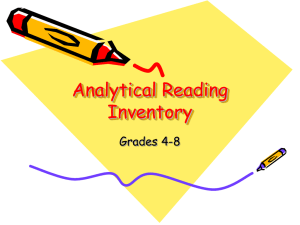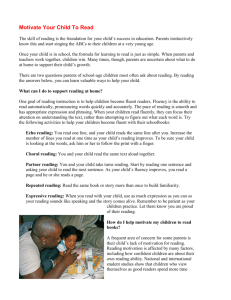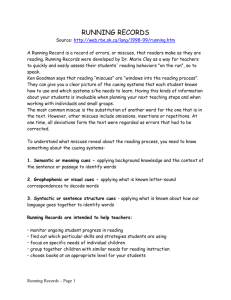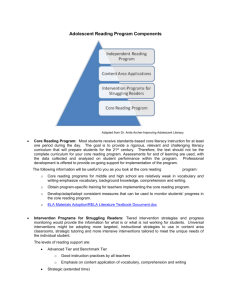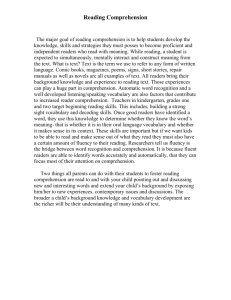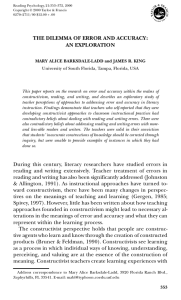Running Records-facts sheet St Therese
advertisement
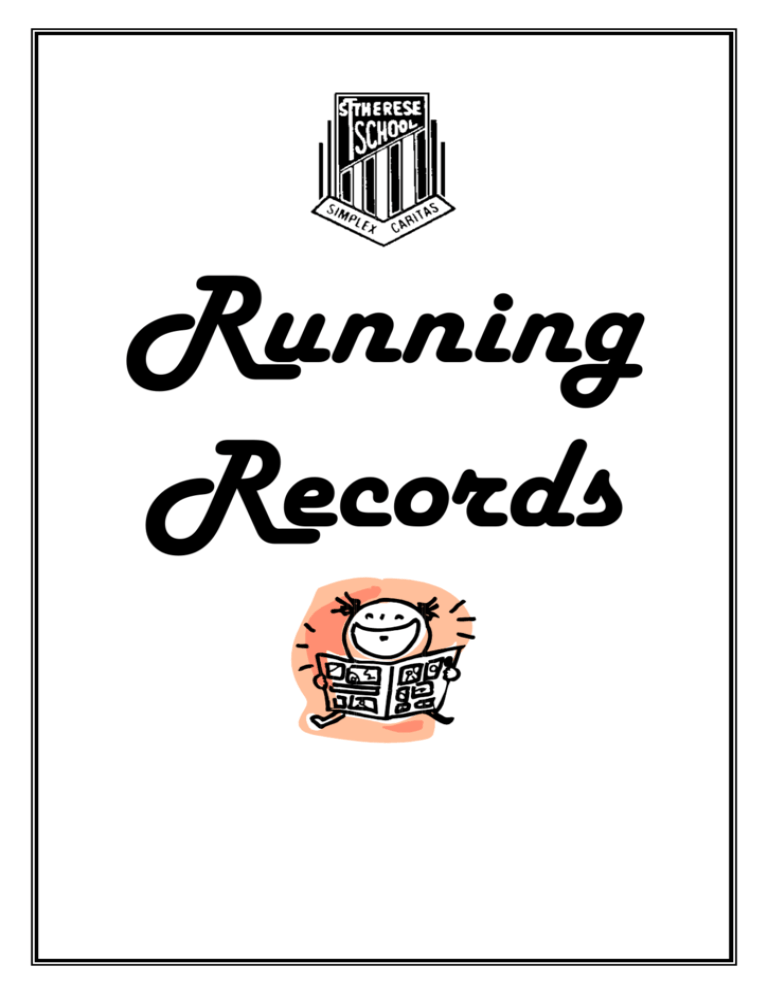
Running Records 2 Running Records What are Running Records? A running record is a record of errors, or miscues, that readers make as they are reading. Running Records were developed by Dr Marie Clay as a way for teachers to quickly and easily assess their students’ reading behaviours “on the run”, so to speak. Running Records capture what the reader did and said while reading. They capture how readers are putting together what they know in order to read. They allow teachers to describe how children are working on text. They allow teachers to hear how children read – fluent, phrased, word by word, acknowledging punctuation, or on the run. (Further reference: Clay, M “Running Records for Classroom Teachers) Why do Running Records? Running Records are intended to: Ascertain a child’s instructional book level (IBL) Monitor ongoing student progress in reading Find out which particular skills and strategies students are using Establish specific needs of the children Group together children with similar needs for reading instruction Choose books at an appropriate level for your students Ken Goodman says that reading “miscues” are “windows into the reading process”. They can give you a clear picture of the cueing systems that each student knows how to use and which systems they need to learn. Having this kind of information about your students is invaluable when planning your next teaching steps and when working with individuals and small groups. It is essential that we ascertain the child’s “instructional” reading level as it is at this level that the child can learn. *When you are asked to provide a child’s reading level it is the INSTRUCTIONAL LEVEL which is required! 3 Taking the Running Record 1. Sit the child beside you and explain that you want them to read this book independently. 2. Read the title of the book. 3. Do a book orientation (BO) – give a brief synopsis of the story line, introducing characters. Don’t give the solution to the conflict. (Note* - record “S” (seen) at top if child has read book before) 4. Use a record form or blank sheet of paper to mark reading behaviour and to record miscues. (Optimal at least 100 words) 5. When a child stops during reading, it is important that you allow enough time for her to work on a problem before you supply the word. It is also important that you don’t wait so long that they lose the meaning of the story while trying to solve the unknown word. 6. Use a standardised system to record the reading – words read correctly, substitutions, omissions, deletions, self-corrections etc. 7. REMEMBER – RECORD NOW, TEACH LATER. To achieve objectivity in records of reading behaviour it is necessary for teachers to be recorder of the behaviour and not a stimulus of behaviour. All comments, teaching points, helpful replies, leading questions and pointing guides have to be dispensed with entirely during a running record. 8. It is important to record how the reading “sounded” – staccato, phrased, fluent (mostly, sometimes, little). 9. Do a brief book response – make a brief comment about the story shows child you have been listening. How often should we take running records? Running records are taken with the greatest frequency at the earlier stages of reading. Children not progressing at the expected rate should be assessed even more frequently than the schedule suggested below. Reader Emergent readers Upper emergent readers Early fluent readers Fluent readers Levels Levels 0 - 9 Levels 10 - 14 Levels 15 - 20 Levels 21+ every every every every Frequency 4 weeks 4 - 6 weeks 6 weeks 8 weeks 4 Analysing running records The most common miscue is the substitution of another word for the one that is in the text. To understand what miscues reveal about the reading process, you need to know something about the cueing systems: 1. Meaning (semantic) cues – applying background knowledge and the context of the sentence or passage to identify words. 2. Visual (graphophonic) cues – applying what is known letter-sound correspondences to decode words. 3. Syntactic (sentence structure) cues – applying what is known about how our language goes together to identify words. Checking for comprehension 1. If self-correction rate (SCR) on the Instructional book is less than 1:3, children are self-monitoring their own reading ie. using their comprehension skills on the run. 2. Have the students retell the story in their own words. They could describe: characters, main idea, sequence of events, setting, plot problem. 3. For a quicker and more objective comprehension check use comprehension questions ask a combination of literal and inferential questions. 5 St Therese Sadleir Running Records - Conventions Reading Behaviour Accurate reading Repetition Self-correction Try that again Substitution Omission Insertion/ addition Convention Counted as an error No No No No Yes R SC TTA played pulled _ played Played ________ A/T Appeal / Told Spelt/ Individual sounds BOAT / b-o-a-t *Teacher prompts “Have a go” YT Yes Yes Yes Yes No Note: Contractions count as 1 error Multiple unsuccessful attempts at a word are counted as one error Repeated errors with proper nouns counts as an error the first time only Each insertion counts as an error therefore you can have more errors than text Skipped line – each word counts as an error or say “Try that again” (TTA) Pronunciation differences are not counted as errors Skipped page – either get them to read it or subtract the number of words on that page from the total number of words to be read. 6 Running Records – Calculations Error Rate 1:200 1:100 1:50 1:35 1:25 1:20 1:17 1:14 1:12.5 1:11.75 1:10 1:9 1:8 1:7 1:6 1:5 1:4 1:3 1:2 Percent Accuracy 99.5 99 98 97 96 95 94 93 92 91 90 89 87.5 85.5 83 80 75 60 50 Reading Level EASY INSTRUCTIONAL DIFFICULT/ HARD CALCULATIONS: RW = Running words, E = Errors, SC = Self-corrections ACCURACY: Running Words Errors Eg. 150 15 = Ratio = Percentage Reading level (See table above) = 1:10 = 90% Instructional level

